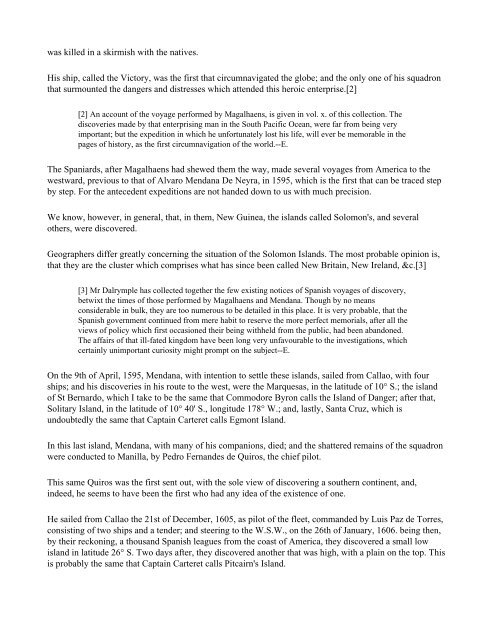A General History & Collection of Voyages and Travels ... - Nauticus
A General History & Collection of Voyages and Travels ... - Nauticus
A General History & Collection of Voyages and Travels ... - Nauticus
Create successful ePaper yourself
Turn your PDF publications into a flip-book with our unique Google optimized e-Paper software.
was killed in a skirmish with the natives.His ship, called the Victory, was the first that circumnavigated the globe; <strong>and</strong> the only one <strong>of</strong> his squadronthat surmounted the dangers <strong>and</strong> distresses which attended this heroic enterprise.[2][2] An account <strong>of</strong> the voyage performed by Magalhaens, is given in vol. x. <strong>of</strong> this collection. Thediscoveries made by that enterprising man in the South Pacific Ocean, were far from being veryimportant; but the expedition in which he unfortunately lost his life, will ever be memorable in thepages <strong>of</strong> history, as the first circumnavigation <strong>of</strong> the world.--E.The Spaniards, after Magalhaens had shewed them the way, made several voyages from America to thewestward, previous to that <strong>of</strong> Alvaro Mendana De Neyra, in 1595, which is the first that can be traced stepby step. For the antecedent expeditions are not h<strong>and</strong>ed down to us with much precision.We know, however, in general, that, in them, New Guinea, the isl<strong>and</strong>s called Solomon's, <strong>and</strong> severalothers, were discovered.Geographers differ greatly concerning the situation <strong>of</strong> the Solomon Isl<strong>and</strong>s. The most probable opinion is,that they are the cluster which comprises what has since been called New Britain, New Irel<strong>and</strong>, &c.[3][3] Mr Dalrymple has collected together the few existing notices <strong>of</strong> Spanish voyages <strong>of</strong> discovery,betwixt the times <strong>of</strong> those performed by Magalhaens <strong>and</strong> Mendana. Though by no meansconsiderable in bulk, they are too numerous to be detailed in this place. It is very probable, that theSpanish government continued from mere habit to reserve the more perfect memorials, after all theviews <strong>of</strong> policy which first occasioned their being withheld from the public, had been ab<strong>and</strong>oned.The affairs <strong>of</strong> that ill-fated kingdom have been long very unfavourable to the investigations, whichcertainly unimportant curiosity might prompt on the subject--E.On the 9th <strong>of</strong> April, 1595, Mendana, with intention to settle these isl<strong>and</strong>s, sailed from Callao, with fourships; <strong>and</strong> his discoveries in his route to the west, were the Marquesas, in the latitude <strong>of</strong> 10° S.; the isl<strong>and</strong><strong>of</strong> St Bernardo, which I take to be the same that Commodore Byron calls the Isl<strong>and</strong> <strong>of</strong> Danger; after that,Solitary Isl<strong>and</strong>, in the latitude <strong>of</strong> 10° 40' S., longitude 178° W.; <strong>and</strong>, lastly, Santa Cruz, which isundoubtedly the same that Captain Carteret calls Egmont Isl<strong>and</strong>.In this last isl<strong>and</strong>, Mendana, with many <strong>of</strong> his companions, died; <strong>and</strong> the shattered remains <strong>of</strong> the squadronwere conducted to Manilla, by Pedro Fern<strong>and</strong>es de Quiros, the chief pilot.This same Quiros was the first sent out, with the sole view <strong>of</strong> discovering a southern continent, <strong>and</strong>,indeed, he seems to have been the first who had any idea <strong>of</strong> the existence <strong>of</strong> one.He sailed from Callao the 21st <strong>of</strong> December, 1605, as pilot <strong>of</strong> the fleet, comm<strong>and</strong>ed by Luis Paz de Torres,consisting <strong>of</strong> two ships <strong>and</strong> a tender; <strong>and</strong> steering to the W.S.W., on the 26th <strong>of</strong> January, 1606. being then,by their reckoning, a thous<strong>and</strong> Spanish leagues from the coast <strong>of</strong> America, they discovered a small lowisl<strong>and</strong> in latitude 26° S. Two days after, they discovered another that was high, with a plain on the top. Thisis probably the same that Captain Carteret calls Pitcairn's Isl<strong>and</strong>.


